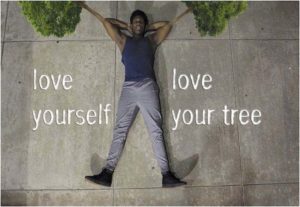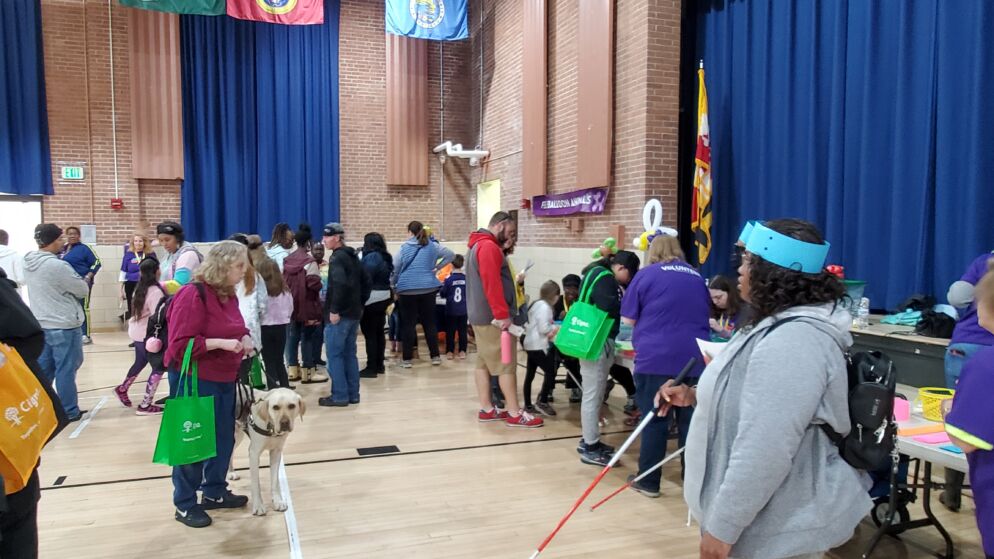The catch phrase is clever: “Love Your Tree.” It’s the name of the annual poster campaign at the Center for Eating Disorders at Sheppard Pratt. Maybe you weren’t thinking about proactive body-image messaging before you read it, but now you are.
“Love Your Tree,” in its 12th year, is an annual campaign organized by the center as a way to reach students across Maryland. It asserts that there are as m any body types as there are trees in the forest, and all are beautiful. And it taps all age groups, elementary school, middle school, high school and even college students, encouraging them to consider their thoughts on self-image.
any body types as there are trees in the forest, and all are beautiful. And it taps all age groups, elementary school, middle school, high school and even college students, encouraging them to consider their thoughts on self-image.
The program is run by Brianna Garrold, an art therapist at the center. “I stepped in to help about six years ago, and I got to shadow a couple of workshops with Julia Anderson, creator of the campaign,” Garrold says. “For the last three years, I have been traveling all over Maryland to meet students and provide poster workshops for them. It’s been a great and fun part of my job.”
The theme was inspired by writer and activist Eve Ensler, who used the image of a tree as a metaphor in her one-woman show, “The Good Body,” which disputes societal definitions of beauty.
Anderson, an expressive art therapist with the Center for Eating Disorders since 1994, liked the imagery and developed “Love Your Tree” in 2006 to inspire creative expression through art as well as promote self-acceptance. And the program has inspired many, Garrold says, adding that art therapy is an integral part of the healing process because it can enable people to express emotions and examine complex inner conflicts.
“Art, music and self-expression are things that kids feel really good about and usually li ke, especially at younger ages, before that kind of self-critical piece takes over,” she says. “Creating art can also help give students positive self-esteem. It’s about getting that snowball of positivity rolling instead of that negativity.”
ke, especially at younger ages, before that kind of self-critical piece takes over,” she says. “Creating art can also help give students positive self-esteem. It’s about getting that snowball of positivity rolling instead of that negativity.”
This year, the center received more than 270 entries for the poster contest, which is a well-timed event: Posters selected to be used by the center will be announced soon, and the last week of February is designated by the National Eating Disorder Association as National Eating Disorder Awareness Week.
Treating anorexia, which is characterized as self-starvation and an inability to maintain adequate body weight, seems simple at the surface: Eat and gain weight. But it’s much more than that, especially for tweens and teens. More than 10 million Americans have eating disorders, which have a 10 percent mortality rate, the highest of any psychiatric illness, according to the National Institute of Mental Health.
Social media can also be a source of distress for people with eating disorders, Garrold says. “All of the (poster) workshops start with this interactive and educational piece, where I talk to students about social media and about how we develop our perceptions about body image at a very young age,” she says. “Some of the places that they are receiving these negative messages from social media are kind of sneaky and sinister. It’s marketing and the way it is implemented in their lives and how all those things portray this idea for students to be unhappy about themselves.”

That’s where programs such as “Love Your Tree” come into play. “Their body image and self-esteem are critical to healthy development,” Garrold says. And it’s important to teach that lesson as early as kindergarten since self-perception can change day to day, minute to minute, she adds. Kids need to know what positively affects it and what negatively affects it.
After this educational piece, Garrold introduces art into the mix and the idea of having a nonverbal outlet for creative expression and self-esteem. And the kids get it.
“Art is a cool vehicle to share your message with people,” she says, adding that once kids show their artwork, it can have a ripple effect that can both inspire and heal. “If somebody sees your poster about what you like about yourself, it might inspire somebody else to then try and embrace what they like about themselves or what they feel positive about,” Garrold says.
A special reception for participating artists and their families will be held in March, where many posters will receive awards and recognition.
“Every student gets their artwork recognized as an actual artist would,” Garrold says. “We select one poster, and we try to call it an overall selection versus a winner. It is reproduced on a postcard that we use as a mailer at the center. Having that student’s message of self-esteem and healthy body image put on this postcard is like a little beacon of hope for people.”








